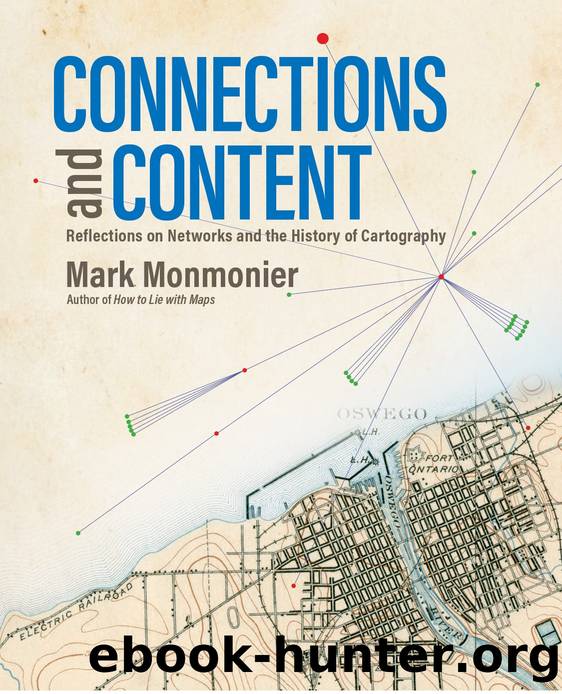Connections and Content by Mark Monmonier;

Author:Mark Monmonier; [Monmonier;, Mark]
Language: eng
Format: epub
ISBN: 9781589485600
Publisher: LightningSource
Published: 2019-07-24T19:22:21+00:00
Figure 5.5. Stations from which telegraphic reports of weather were received at the Smithsonian Institution any time between 1858 and 1860.
Dots that vary in size or grayscale reflect the mostly progressive growth of the Smithsonian telegraph network. The thirty-one large black dots for stations contributing during all three years describe the systemâs early and more durable reach northeastward to New York, westward to Cincinnati, and southwestward to New Orleans, along a route that approximates the physiographic boundary between the Piedmont and the comparatively level coastal plain. The minimalist network in the South is underscored by lateral branches to Lynchburg and Norfolk, Virginia; Wilmington, North Carolina; Charleston, South Carolina; and Savannah and Atlanta, Georgia. The long Shenandoah Valley, west of the Blue Ridge Mountains, provided an efficient route to Knoxville, Tennessee, not included on the 1853 Barr map. The ten dots in the second-most common category show significant extensions beyond New York to Burlington, Vermont; beyond Cleveland to northern Illinois and Iowa; and beyond Cincinnati to St. Louis, Missouri, and Cairo, Illinois.
Henryâs network reflects dominant atmospheric currents as well as the geography of telegraph lines. Although the telegraph network was comparatively well developed in New York and New England, the weather there was less relevant to the Washington forecast than conditions in the Midwest. The handful of temporary additions such as Jackson, Mississippi, and two stations in central and southwestern Virginia that contributed reports only in 1859 were apparently of limited interest in Washington. That Gainesville, Mississippi (near the Louisiana border and the Gulf of Mexico), dropped out after reporting during 1858 and 1859 was probably of little consequence because of its proximity to New Orleans.
Particularly noteworthy is the elongated cluster of nine dots to the west and northwest between Washington and Cincinnati and including Pittsburgh. Their importance to Henry and his congressional supporters is apparent in the 1860 report, in which he expressed âregret that frequent intermissions take place in the receipt of the telegrams from places directly west of the city of Washington, especially as we are more immediately interested in these, since they afford the means of predicting with considerable certainty the character of the weather sometimes a day or more in advance.â52 The Washington establishment was a key part of Henryâs consumer base.
Hiccups in the 1860 telegraphic reports were minor compared with the disruption after South Carolina seceded from the Union in late December 1860 and ten more states followed over the next six months. In his annual report for 1861, Henry lamented, âThe system of meteorological observations, organized and carried on successfully for several years past, has suffered more from the disturbed condition of the country than any other part of the operations of the Smithsonian establishment.â53 The Civil War affected the correspondence network when federal troops were withdrawn from military posts in the nationâs interior and along the Pacific coast, but the warâs impact on the telegraph network was even greater. Not only were reports from the South âinterruptedâ but âthe wires from the North
Download
This site does not store any files on its server. We only index and link to content provided by other sites. Please contact the content providers to delete copyright contents if any and email us, we'll remove relevant links or contents immediately.
Whiskies Galore by Ian Buxton(41707)
Introduction to Aircraft Design (Cambridge Aerospace Series) by John P. Fielding(33011)
Small Unmanned Fixed-wing Aircraft Design by Andrew J. Keane Andras Sobester James P. Scanlan & András Sóbester & James P. Scanlan(32678)
Craft Beer for the Homebrewer by Michael Agnew(18071)
Turbulence by E. J. Noyes(7886)
The Complete Stick Figure Physics Tutorials by Allen Sarah(7257)
Kaplan MCAT General Chemistry Review by Kaplan(6809)
The Thirst by Nesbo Jo(6747)
Bad Blood by John Carreyrou(6466)
Modelling of Convective Heat and Mass Transfer in Rotating Flows by Igor V. Shevchuk(6347)
Learning SQL by Alan Beaulieu(6151)
Weapons of Math Destruction by Cathy O'Neil(6073)
Man-made Catastrophes and Risk Information Concealment by Dmitry Chernov & Didier Sornette(5864)
Digital Minimalism by Cal Newport;(5575)
Life 3.0: Being Human in the Age of Artificial Intelligence by Tegmark Max(5393)
iGen by Jean M. Twenge(5292)
Secrets of Antigravity Propulsion: Tesla, UFOs, and Classified Aerospace Technology by Ph.D. Paul A. Laviolette(5231)
Design of Trajectory Optimization Approach for Space Maneuver Vehicle Skip Entry Problems by Runqi Chai & Al Savvaris & Antonios Tsourdos & Senchun Chai(4948)
Electronic Devices & Circuits by Jacob Millman & Christos C. Halkias(4859)
